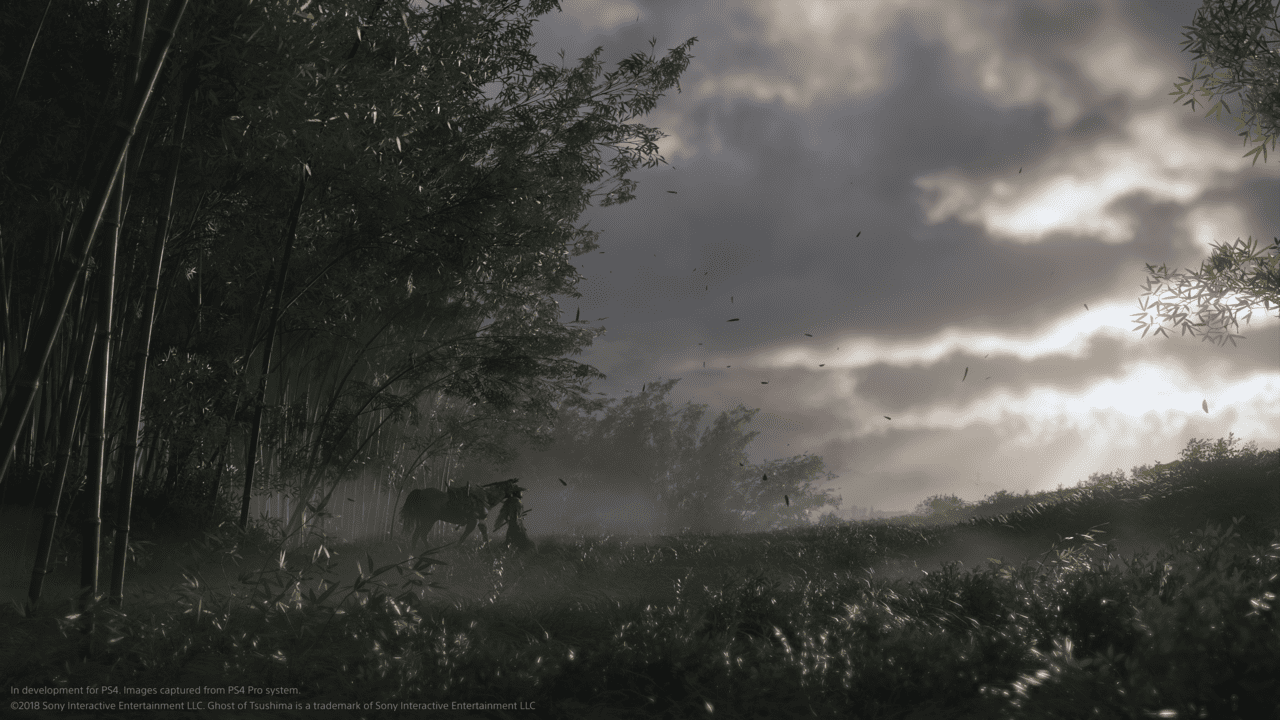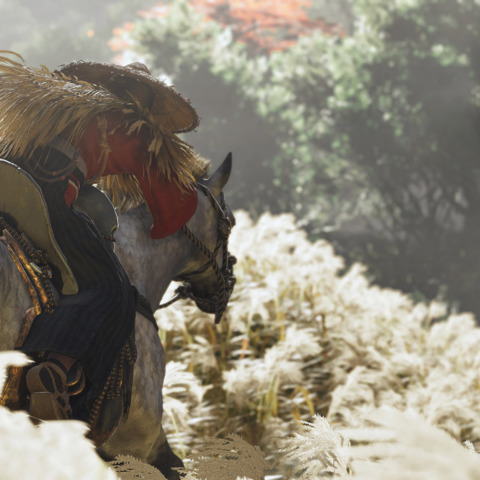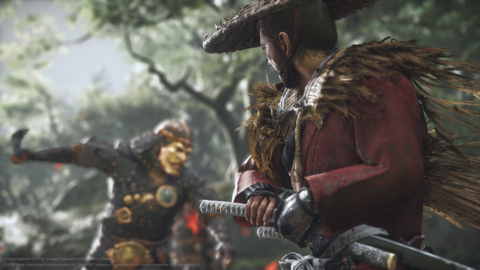Talking to Chris Zimmerman, Sucker Punch co-founder and programmer on Ghost of Tsushima, it’s clear his latest game is a dream project that’s given purpose to his innate passion for Japanese history. The upcoming PS4 game is based on an actual 13th-century Mongol invasion that serves as catalyst for the fictional hero’s transformation from quintessential samurai to scrappy shadow warrior.
According to Zimmerman, Sucker Punch has gone to considerable lengths to study the island of Tsushima and understand its past, and he believes eagle-eyed historians will appreciate the numerous authentic touches throughout–details so subtle as to be lost on the average player, but details deemed important nonetheless.
As jazzed as Zimmerman is about these efforts, he’s also confident that it’s worth taking creative liberties to make Ghost of Tsushima as relatable as possible. Thanks to comics, games, and movies, people have an idea of what samurai are supposed to look like, and this is what Sucker Punch is aiming for. Think the characters we’ve seen thus far are wearing authentic 13th century samurai armor? Not so, according to Zimmerman.
In the excerpt from our E3 2018 interview below, Zimmerman further explores the reasoning behind the team’s selective commitment to fact, and identifies some aspects of the game that have been moulded to fit mainstream expectations of samurai.











GameSpot: What’s the balance of historical accuracy in Ghost of Tsushima?
Zimmerman: The way I think about it is: we’re going to deviate from historical truth, we just want to do it intentionally. A lot of the support we get from our friends from Sony in Japan, and our Japanese friends in Sony US, and all the cultural consultants we’ve assembled to help us do this stuff, is to make sure we don’t deviate accidentally. There are things we are going to do that are different and we want to choose those wisely.
There are places where we’re really pretty true, right? Like if we’re putting birds in the game, they’re Japanese birds. Brad Meyer, our sound lead, took a trip to Japan to capture the actual sounds of things in nature… It’s an awesome game to work on because it lets us do this cool stuff. So, stuff like that is going to be perfect, like the statues that you see in the temple, in the demo, those are actual 13th-century statues.
And then there are things where, well, there’s some stuff where the consultants help us not make mistakes. If anyone asked that question, I probably gave the example of us rewriting that scene, with Jin and Masako, when they meet. Originally we wrote it as, „Hello, Jin.“ Ryuhei, our producer, said, „Yeah, Japanese people don’t say that. She would just say, ‚Jin.'“ Little stuff like that, just to make sure that if you’re a Japanese speaker or if you’re Japanese, you don’t snag on stuff.

I asked him another one today, I was like „Ryuhei, in the English version the horse is named Nobu–a Japanese name–[so]why is it that when we did it in Japanese they changed the name?“ He said, „Oh, we didn’t change the name, you just don’t give horses names in Japan; that’s an American thing.“ So when he calls the horse, [Jin] says, „Hey, over here,“ and the horse comes. He doesn’t give him a name.
Things like that are going to fly over most players, and that’s okay. Knowing that we’re trying to get that stuff right, and knowing there are people that notice and appreciate that the Kanji are actual 13th century Kanji, that actually is why we’re doing it. I think people not necessarily seeing those details or realizing the lengths we’ve gone to to make sure it’s true at where we want it to be true, they still benefit because it just adds a level of coherence to the whole thing, that it’s not made up.
The challenge for us, making a game, in an original story but taking place in a real historical time, is making sure we’re telling a story that people can relate to, you know, that they can empathize with. So when we are deviating from this historical truth, we are doing it to stop you from snagging on stuff.
If you have an idea about what samurai look like or how they act or how they think we’re going to give that to you. Most people’s idea is really based on an idea of samurai which is really more of a 16th-, 17th-, 18th-century idea of samurai; 13th century, historically, is pretty different. In terms of how they fought, what they wore, it doesn’t match your expectations. So we’re not sticking exactly to the historical truth of Kamakura-era samurai. It’s gonna be a little different. The armor that you see him wear, it’s not 13th century armor. It’s more warring states period armor. Because, honestly, the 13th century armor is pretty jarring looking, it’s not what you’d expect. It’s really boxy. It doesn’t look aspirational. And we wanna make sure that what we give you is your fantasy of what being a wandering samurai is.
You need a javascript enabled browser to watch videos.
Ghost Of Tsushima – Official Gameplay Trailer (Japanese Language) | E3 2018
Please use a html5 video capable browser to watch videos.
This video has an invalid file format.
Sorry, but you can’t access this content!
Please enter your date of birth to view this video
By clicking ‚enter‘, you agree to GameSpot’s
Terms of Use and Privacy Policy
How do you manage the realities of fighting with a Katana while making a video game that’s not Bushido Blade?
We tried it both ways. The truth is, if you ever pick up a katana and you actually hold it in your hands, you realize how dangerous it is. It’s sharp, and it’s kind of scary to hold one. If you get hit with a katana for real, unless it’s just a nick, the fight’s over. True, historic fighting styles are built around that idea. The ancient fighting style expert that comes and helps us, and does mo-cap, has been really helpful in helping us find that balance, where there is a historical basis to how you move.
The movement style for Jin, when he’s fighting, is actually pretty grounded, and wasn’t necessarily what we would have done to begin with. He helped us find the right style and to identify what in the movement of the characters makes them feel like samurai, and what do we do with the mongols, who move very differently–he’s also an expert in ancient mongolian combat, by the way–so that also helped us make sure that you can feel the difference in this clash of cultures show up in the fights that you have.
But, there are things that Jin does when you’re fighting that no samurai would ever do. He does spin strikes, which are fun, they’re very showy, they are completely… you would never do that [in real life]. You would never turn your back. There are things that he does even right now that we may continue to edit as we look for that balance. We’ll see if we can find the best of both worlds, where it’s as real as it can be while still being a video game.
We’ve tried versions of the game where it’s all one-hit kills, and it’s not as much fun to play. It’s not just about your expectations of what a samurai is, which are really more formed by watching movies than by careful academic study. It’s also, whether people know it or not, people’s experience playing games–samurai games, fighting games, or whatever sort–your expectations are kind of set by that. So we have to play within that set of expectations to make you [think], „I feel like a samurai!“ You don’t want it to be jarring, you want it to be natural. There are so many natural barriers between you and this time-machine experience that we’re going for, that we have to be careful to take all the barriers that we can get rid of and get rid of them.
Website: LINK


